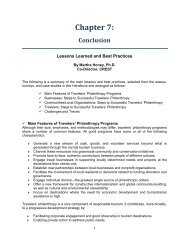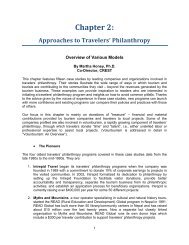Travelers' Philanthropy Handbook - Center for Responsible Travel
Travelers' Philanthropy Handbook - Center for Responsible Travel
Travelers' Philanthropy Handbook - Center for Responsible Travel
Create successful ePaper yourself
Turn your PDF publications into a flip-book with our unique Google optimized e-Paper software.
the traveler is given hope, empowerment, and practical evidence that contributions can trulymake a difference.• How can Companies in<strong>for</strong>m <strong>Travel</strong>ers about their <strong>Travel</strong>ers’ <strong>Philanthropy</strong>Projects?oooooooIn company brochuresTheir website, possibly with links to the partner organization or project’s web-site.Newsletters - preferably electronic to reduce paper waste and ensure immediacy.An in<strong>for</strong>mation sheet, flyer or pamphlet sent in advance of their trip or provided uponarrival, or detailed in the trip dossier or notes which are provided upon booking.Blogs - regular updates from staff, volunteers, or visitors at the project.As part of a company’s <strong>Responsible</strong> <strong>Travel</strong> or Sustainability reporting. Note thatphilanthropic support should be one component of a company’s sustainabilityreporting, and not held up as a dominant activity. Statements that imply “Thecompany gives to charity so they must be OK” can provoke cynicism and raisequestions about the ethics of how the company operates and cares <strong>for</strong> its'stakeholders and communities.Featuring projects on travelers' philanthropy websites. For example:<strong><strong>Travel</strong>ers'</strong> <strong>Philanthropy</strong>: http://www.travelersphilanthropy.org/index.html<strong>Travel</strong> Pledge: http://travelpledge.org/• How Should Project Visits be Handled?Visiting a travelers’ philanthropy project should be apositive experience <strong>for</strong> all parties. But to make it sorequires both planning and sensitivity to the needsand capacity of the community where the project islocated. There should be a local employee orrepresentative present to welcome visitors anddescribe their work (possibly with the guide or groupleader translating). There should be some activityin progress or some displays representing theirwork. It is important to offer an alternative activity orlocation <strong>for</strong> travelers who do not want to participatein the site visit.Visit to The Alola Foundation, Dili, Timor-Leste.Credit: Jane CrouchThe visit should not feel ‘voyeuristic’ or uncom<strong>for</strong>table <strong>for</strong> either the visitors or the locals. Someprojects by their nature are not appropriate to visit. These may include:o A clinic - patients dealing with reproductive health, family planning, victims of violence,HIV/AIDS or other serious health issues naturally want privacy.o A school when classes are underway - unless pre-arranged.o A project related to disease management - human or animal, where visitors mayintroduce germs or spread germs after their visit.o An orphanage or other institution involved in child welfare – unless pre-arranged andwell-managed (please note further points below under ‘Important considerations <strong>for</strong>caring <strong>for</strong> children’)Timing and frequency of visits must be negotiated and pre-arranged to avoid disrupting therecipient organization’s key activities and to allow <strong>for</strong> coordinated, well-staffed presentations.163















